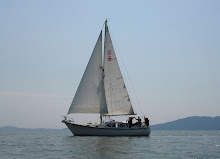When you first tie up to the docks of Hydaburg, you have to really look at the slip you are trying to tie up in. Somebody might be parked there already.
The docks were in pretty rough shape, but not all of the boats in town fared so badly. This dugout canoe looked ready to go raiding.
As we strolled around town, several folks asked us if we'd seen the carving shed. Obviously a source of pride for the whole town, they have a group of master Haida carvers who run a training and apprenticeship program for cedar carving. Warren, the fellow in the middle was the head carver, and talked with us for hours about the program.
The main push at the time was to recarve four traditional poles that were originally family poles and moved to Hydaburg when the resident's settled there to open a school. They are planning to raise four poles (80-100 people are needed to move each pole) in July, and they have two to finish.
The woodwork is beautiful. Many of the carving tools are handmade, and the smell of all that cedar is wonderful.
Some of the students displayed other handiworks as well. This spoon and halibut hook were interesting. Apparently these hooks are designed so the halibut has to really grab the hook to get the bait.
The hook is tied to a rock with a bouy attached. The fisherman simply drops the whole thing overboard and in the morning looks for the float, whick usually hasn't moved very far. Some floats were ingeniously designed to float differently when a fish was on, so the person could know in a glance if he needed to paddle out.
These steam-bending boxes were also pretty ingenious, for softening the corners of the bentwood boxes. Squeezed together, and fed pressurized steam, the carvers can bend a 1-inch think wood plank to a 90-deg angle after just 10 minutes.
The town seems to be genuinely trying to salvage their language and collective identity. There is a lot of pride in the carving program, and the streat signs are way cool.
Our only complaint is the rough treatment of amphibians. Every pole we see has the frog (or toad) being eaten by some creature or another. We want to see the frog eating the raven for a change, okay?














.JPG)
.JPG)
.JPG)

